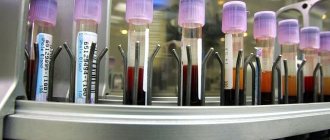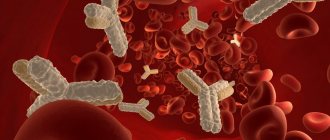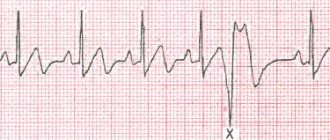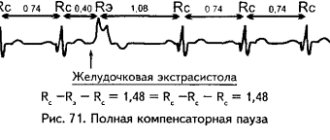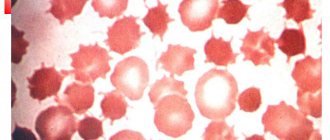V.V. Osovskikh1, M.S. Vasilyeva2, A.E. Bautin2, L.N. Kiseleva1
1 Federal State Budgetary Institution Russian Scientific Center of Radiology and Surgical Technologies named after. A.M. Granova, St. Petersburg, Russia
2 Federal State Budgetary Institution National Medical Research Center named after. V.A. Almazova, St. Petersburg, Russia
For correspondence: Viktor Vasilievich Osovskikh – Ph.D. honey. Sciences, doctor of the department of anesthesia and resuscitation of the clinic of the Russian Research Center for Chemistry and Chemistry of Chemistry named after. A.M. Granova, St. Petersburg, Russia; e-mail: [email protected]
For citation: V.V. Osovskikh, M.S. Vasilyeva, A.E. Bautin, L.N. Kiseleva. Prognostic value of individual markers of hypercoagulation in sepsis. Bulletin of Intensive Care named after. A.I. Saltanova. 2020;3:66–73. DOI: 10.21320/1818-474X-2020-3-66-73
Essay
Relevance. Sepsis is a heterogeneous syndrome caused by an imbalanced host response to infection, leading to organ dysfunction. The coagulopathy that develops has varying degrees of severity, and the incidence of overt disseminated intravascular coagulation (DIC), depending on the diagnostic criteria, varies from 30 to 60%. Although diagnosing overt disseminated intravascular coagulation is not difficult, identifying the hypercoagulable stage that precedes it is problematic because it is not detected by available coagulation screening tests. The lack of early diagnosis hinders the development of preventive therapy for DIC.
Purpose of the study. To evaluate the frequency of detection of individual hypercoagulable markers in septic patients with a hypercoagulable thromboelastometry (TEM) pattern and their relationship with disease outcome.
Materials and methods. Screening patients with sepsis using TEM identified 85 hypercoagulable patients. A thrombin generation test with the addition of thrombomodulin was performed from plasma samples, screening indices of coagulation, levels of physiological anticoagulants, and selected markers of hypercoagulability were determined. Subsequently, the groups of survivors and those who died were identified.
Results. The group of survivors included 62 patients, those who died - 19. In the thrombin generation test, hypercoagulation was detected only in 7 cases. The groups of survivors and those who died did not differ significantly in the degree of decrease in endogenous thrombin potential: 20 (10–25)% and 14 (10–31)%, respectively, and peak thrombin concentration: 8 (2.9–16)% and 7 (3– 18)% respectively. The groups of survivors and those who died were significantly different: protein C 79.5 ± 28% and 64.9 ± 25%, factor VIII 226.4 ± 66% and 276.6 ± 94%, von Willebrand factor 269 ± 129% and 435 ± 181 %, antithrombin 82 (60–94) % and 65 (41–80) % and D-dimer 2157 (1341–3964) μg/L and 3253 (1911–6914) μg/L, respectively.
Conclusion. Patients with sepsis who have signs of hypercoagulation according to TEM criteria have different combinations of thrombophilia markers. Local screening coagulation tests do not affect prognosis. Low levels of protein C and antithrombin, as well as high levels of factor VIII, von Willebrand factor, and D-dimer, have a moderate prognostic value and can potentially influence therapy.
Key words: sepsis, thrombophilia, thromboelastography, thrombin, thrombomodulin, disseminated intravascular coagulation
Received: 15.03.2020
Accepted for publication: 02.09.2020
Read article in PDF
Statistics Plumx Russian
What is this condition
Hypercoagulation syndrome is not common among the population. According to official statistics, there are 5-7 cases of the disease per 100,000 people. But knowing what it is and how to avoid the risk of the syndrome is absolutely necessary.
The disease is based on a high level of blood clotting due to changes in its composition.
The usual standard for the liquid to solid ratio is 60 to 40%. Due to a lack of fluid, nutrients or other reasons, the plasma in the blood tissues becomes much smaller, and denser elements predominate.
As a result, the blood becomes very thick, loose and sticky. This qualitatively changes its coagulability.
In a normal person, bleeding stops after 2-4 minutes, and a clot remaining on the skin forms after 10-12 minutes. If it occurs earlier, it is suspected that it is prone to hypercoagulability and the necessary tests must be performed to identify the abnormality.
Stages and forms
Hypercoagulation is the initial stage of the development of serious diseases associated with impaired hemostasis - the process of blood clotting. The development of hypercoagulation syndrome is expressed in different ways.
Stages
The first stage is characterized by failures in the formation of blood clots, which entails disruption of the functions of the vascular system.
If this pathology develops, there is a risk that the blood clot completely envelops the blood vessel and stops the blood supply to the body.
The sources of the disease are hidden in the patient’s medical history and have different origins.
Forms
- Congenital pathology. Initially, disturbances in the qualitative or quantitative composition of blood tissue are observed.
- Acquired form. This is a consequence of infectious, viral, cancer and many other diseases.
The second form of structural hypercoagulation occurs mainly in older people. People over 50 are characterized by a physiological age-related decrease in fibrinolysis.
Risk factors
These include:
- Unhealthy lifestyle: excessive alcohol consumption, smoking, excess weight.
- Lack of fluid, which entails a lack of complete plasma composition.
- Enzymopathy is a pathological condition associated with improper breakdown of food; dense, unprocessed fragments enter the bloodstream.
- Containing foods in the diet that impair the digestion of foods, especially proteins and carbohydrates.
- Lack of water-soluble vitamins that improve blood quality.
- Liver disease due to impaired biosynthetic function.
- Bacterial infections.
- Dysfunction of the spleen and adrenal glands.
- Damage to blood vessels.
- Diseases such as uterine fibroids, lipoma and leukemia.
- Systemic diseases of the connective tissue of the body (for example, vascular inflammation).
- Misuse of drugs.
There is also a risk of increased blood clotting in patients who have had heart surgery, especially valve or stent implantation. In this case, it is necessary to conduct an additional examination - a coagulogram, and also administer thrombolytic drugs during the operation.
You can reduce the risk of pathology even in the presence of the above diseases through proper nutrition, maintaining the body’s water balance and carefully monitoring the consumption of carbohydrates, sugar and fructose.
Introduction
Sepsis is a heterogeneous syndrome caused by an imbalanced host response to infection, leading to organ dysfunction [1]. The pathogenesis of coagulopathy developing against the background of sepsis includes several mechanisms.
A decrease in antithrombin levels is detected in half of patients with sepsis, and protein C deficiency is detected in the vast majority. Under physiological conditions, antithrombin inhibits thrombin and other coagulation factors (VII, IX, X and XI), and protein C, activated by the thrombin–thrombomodulin complex on the surface of endothelial cells, inactivates factors Va and VIIIa, breaking positive feedback loops and acting as a natural anticoagulant. A state of increased procoagulant activity and impaired fibrinolysis leads to the formation of fibrin clots in the microvasculature and, as a consequence, organ failure [2, 3]. Coagulopathy has varying degrees of severity, with the incidence of overt disseminated intravascular coagulation (DIC) reaching 30% when assessed according to the International Society on Thrombosis and Haemostasis (ISTH) criteria and about 60% according to the Japanese Association for Acute Medicine (JAAM) criteria. [4]. The question remains controversial whether the severity of DIC is independent of the Acute Physiology and Chronic Health Evaluation (APACHE) II score and Sequential Organ Failure Assessment (SOFA) score a predictor of death, or whether the prognosis is determined by the severity of the general condition. The first statement has dominated the literature since the publication of the PROWESS study in 2004. An alternative opinion was expressed in 2021 based on the results of a large epidemiological study of DIC in Japan, where the authors showed the superior prognostic value of the APACHE and SOFA scales over the existing DIC scales (ISTH and JAAM) [4]. Although diagnosing overt DIC syndrome according to ISTH criteria is based on publicly available markers and is usually not difficult, identifying this (advanced) stage of septic coagulopathy not only does not open up new therapeutic options, but also sharply reduces the effectiveness of existing ones. Experimental studies of endotoxemia confirm the presence of a hypercoagulation phase preceding the development of hypocoagulation [5]. Detection of the earlier (hypercoagulable) stage of DIC in the clinical setting poses a diagnostic challenge because common coagulation screening tests are either insensitive or nonspecific in this regard. This, in turn, hinders the development of targeted preventive therapy at the early stage of DIC.
Currently, it is common to divide methods for diagnosing hemostasis into integral (evaluate the operation of the system as a whole) and local (evaluate individual links or individual factors). In turn, local tests are divided into screening and specialized. The most popular screening tests are prothrombin time and activated partial thromboplastin time. It has been shown that individual coagulation markers (hereinafter we will refer to them as specialized tests) highly correlate with the presence of hypercoagulable shifts in the hemostatic system against the background of sepsis, but their use in clinical practice is not routine. The most frequently mentioned in the context of diagnosing hypercoagulation are D-dimer, protein C, protein S, antithrombin, factor VIII, and von Willebrand factor.
Integrated coagulation tests, such as thromboelastography (TEG), thromboelastometry (TEM), have become widespread as methods for monitoring coagulopathies associated with surgery and trauma. One of the advantages of global tests is their ability to detect hypercoagulability. It is known that TEG and TEM are suitable for identifying hypercoagulability and predicting thrombotic complications in certain groups of patients [6, 7], but their use in conditions of sepsis is controversial [8]. Since TEG/TEM techniques are as close as possible to the patient (the so-called point of care testing), they are obvious candidates for screening the global status of the coagulation system and primary risk stratification. The choice of TEG/TEM criteria for hypercoagulation should be discussed separately. When comparing TEM parameters of healthy volunteers and patients with confirmed thrombotic complications, it was found that the most specific and sensitive markers of thrombotic complications are clot formation time (CFT), maximum clot density (MCF) and thrombodynamic potential according to C. Ruby, which is the quotient of maximum elasticity and clot formation time (TPI = MCE/CFT) [7]. Since maximum clot density is due to the contribution of both fibrin and platelets, a new parameter, “delta,” has been proposed to distinguish between platelet and plasma hypercoagulability. According to the basic algorithm of TEG/TEM operation, the initial period of time r (in TEG devices) or the so-called thrombus formation time (CT) (in TEM devices) ends when the “branches” of TEG/TEM diverge by 2 mm. However, it is at the end of this time interval that active generation of thrombin begins. By displaying the first derivative of the change in clot density (i.e., velocity), it is possible to see the beginning of this process and thus calculate the delta time from the beginning of the first derivative curve to the end of the interval r (or CT). The combination of a high maximum clot density with a short “delta” (less than 0.6 min) is associated with plasmatic hypercoagulation, and the combination with a longer “delta” is associated with platelet hypercoagulation [9]. The connection between normo-, hyper- and hypocoagulation patterns of TEG/TEM and the course of sepsis was traced in a study by S. Ostrowski et al. [5]. The maximum TEG amplitude (corresponding to the maximum clot density in TEM tests) was chosen as the basic criterion. It was shown, in particular, that at the time of diagnosis of sepsis, 22% of patients had a hypocoagulable and 30% had a hypercoagulable TEG pattern. In most patients, the initial TEG characteristics were maintained throughout four days of observation. The development of hypocoagulation on any day of the study was an independent risk factor for death. Identification of a hypercoagulation pattern against the background of sepsis had no prognostic significance; the mortality rate of patients in this group did not differ significantly from the normocoagulation group. The association of hypocoagulation disorders TEG/TEM, which developed against the background of sepsis, with an unfavorable outcome was confirmed in a number of other studies [8], which is consistent with the presence of obvious DIC syndrome in this group of patients. The thrombin generation test is also an integral hemostasis test. The most widely used method is fluorescent detection and automated calculation of the amount of thrombin, proposed by C. Hemker. The acceptable platelet content in plasma depends on the purpose of the study. From a practical point of view, the use of platelet-poor plasma is preferable, as it allows samples to be frozen and stored, and also simplifies the procedure for interlaboratory control. Data from studies using the original method of C. Hemker, performed in the early stages of sepsis development, are contradictory. A number of observations did not demonstrate an increase in thrombin generation, which could explain the hypercoagulable status of patients [10]. On the contrary, in a study by Russian authors, an increase in thrombin generation was noted in patients with abdominal sepsis [11]. In this regard, it is of interest to modify the thrombin generation test with the addition of recombinant human thrombomodulin (protein C activator), which allows, to some extent, to simulate in vivo coagulation conditions. The dose of thrombomodulin is selected to reduce the area under the thrombin concentration curve (the so-called endogenous thrombin potential, ETP) by 50% and the peak thrombin concentration (Peak) in the plasma of healthy donors by 40%. An insufficient decrease in Peak and ETP indicates abnormalities in the protein C system. The question of the combination of the hypercoagulable status of patients with sepsis (based on TEG/TEM screening) and other markers of hypercoagulability, as well as the prognostic value of such combinations, is the object of our study.
The purpose of the study was to evaluate the frequency of detection of individual hypercoagulable markers in septic patients with a hypercoagulable TEG/TEM pattern and their relationship with disease outcome.
Symptoms and signs
The main principle of healthy blood and the whole body is timely treatment. If there are precipitating bleeding disorders or questionable tests, it is necessary to conduct a proper interview and study the accompanying symptoms.
Symptoms of the pathology include:
- Fatigue, “flies in the eyes”, blurred vision due to lack of oxygen.
- Evenly throbbing headaches.
- Dizziness with short-term loss of coordination.
- Muscle weakness and tremors.
- Severe nausea.
- Loss of sensation in the limbs, tingling, burning and complete disappearance.
- Dry skin and mucous membranes, frequent bruises (even with light).
- A noticeable reaction to cold is trembling, brooding.
- Poor sleep, attacks of shortness of breath.
- Painful sensations in the heart area - tingling, rapid heartbeat, shortness of breath, shortness of breath.
- Depression with accompanying nervous disorders, tearfulness.
- Burning of the mucous membrane of the eyes, sensation of excess particles.
- Slowing down blood flow in wounds, causing rapid “clotting”.
- Multiple terminations of pregnancy.
- Systemic diseases.
- Frequent urge to yawn.
- Cold extremities, heaviness in the legs, venous pathways are clearly visible.
Only the presence of several of the above symptoms at the same time allows one to think about blood clotting disorders among other pathologies. However, to make a correct diagnosis, a number of specialized medical examinations are necessary.
Diagnostics
Along with the first symptoms that appear in your appearance and well-being, changes in blood tests also appear. Signs of hypercoagulability are also visible in many ways.
Blood parameters
- CIC analysis. The presence confirms the progression of foreign bodies in the body, indicating activation of complement C1-C3.
- Erythrocytosis - an increase in the number of red blood cells from 6 T/l.
- Hyperthrombocytosis - platelet count 500,000 per cubic mm.
- Hemoglobin 170 g/l.
- Fluctuations in blood pressure, tendency to low readings.
- Increased prothrombin index (more than 150%).
- Symptom of platelet aggregation (sticking).
Also, clinical examination of plasma reveals the formation of spontaneous clots. This indicates a clear course of hypercoagulation.
Sometimes diagnostic difficulties arise due to the complete absence of specific clinical symptoms, since most symptoms are characteristic of other cardiovascular diseases, for example, the central nervous system.
Discussion
We found that patients with sepsis who have the same TEM pattern of hypercoagulation, nevertheless, have a different combination of thrombophilia markers, which casts doubt on attempts to replace coagulopathy with any one single-component drug. When planning studies to correct septic coagulopathy, it is necessary to take into account the heterogeneity of this group of patients. As critics point out, the failure of clinical trials of various anticoagulants in sepsis stems from a failure to identify patients who are more likely to respond positively to the test drug. Examples include studies of activated protein C (except PROWESS), antithrombin, tissue factor pathway inhibitor. The history of the thrombomodulin study (SCARLET), which ended negatively quite recently, is interesting [12]. The criterion for inclusion in the study was an increase in the international normalized ratio to 1.4 with a platelet level from 30 to 150·109/l. In most cases of sepsis, this combination will be observed with the development of overt DIC. It turns out that the drug, the main (but not the only) effect of which is the launch of natural anticoagulant mechanisms, was proposed to be administered already in the hypocoagulation phase of DIC. It may be better to select a more appropriate therapeutic window during the hypercoagulable phase for administration of the drug, and also to first test the highly variable effect of thrombomodulin in vitro (for example, in the thrombin generation test with thrombomodulin).
We believe that when identifying hypercoagulability in sepsis, it is necessary to measure the level of physiological anticoagulants (antithrombin, protein C), as this potentially opens up new therapeutic options. D-dimer, factor VIII, von Willebrand factor and a decrease in the level of thrombin generation have a certain prognostic value. However, the number of factors studied, their sequence and frequency of tests remain unknown and require further analysis, since the direct process of transition from hypercoagulation to overt DIC in a clinical setting has not been studied in detail.
Prevention and treatment
The causes of vascular diseases often lie in late diagnosis and lifestyle provocations. Addiction to smoking, alcohol, junk food and sugar are harmful to your health. Therefore, prevention is important to prevent disease and blood clots.
Prevention
- Diet.
- Quitting smoking and drinking alcohol.
- Avoid intense physical activity.
- Walking through a coniferous forest or just in a green park.
You should exclude sweets, pickles, salty and fried foods, as well as bananas, potatoes and carbonated drinks from your diet. Carbohydrates can be obtained in the form of vegetables, fruits and natural juices.
Tea should be unsweetened, marmalade and sweets are allowed to a minimum.
Protein - in the form of porridges and cereal soups, lean meat and fish. For oils, it is better to use butter and olive oil in small quantities.
Medicines
Don't forget to schedule medical help. There is no need to look for substitutes; you should only take what the doctor prescribed.
During treatment, drugs that dilute platelets are often used: aspirin, heparin, fragmin, clopidogrel, chimes, pentoxifylline, etc. To this are added physiotherapy and injections of vitamins E, C, P (or taking them in tablets).
Folk remedies
Treatment at home is allowed only in combination with a therapeutic regimen. Folk recipes are based on the medicinal effects of plants - grapes, string, licorice, etc.
Also, take 1-2 tablespoons of honey in the morning on an empty stomach, and also use garlic and any raspberry jam.
Literature
- Singer M, Deutschman CS, Seymour CW, et al. The Third International Consensus Definitions for Sepsis and Septic Shock (Sepsis-3). JAMA. 2016; 315(8): 801. DOI: 10.1001/jama.2016.0287
- Iba T., Levy JH, Raj A., et al. Advance in the Management of Sepsis-Induced Coagulopathy and Disseminated Intravascular Coagulation. J. Clinical Medicine. 2019; 8(5): 728. DOI: 10.3390/jcm805072
- Scarlatescu E., Juffermans NP, Thachil J. The current status of viscoelastic testing in septic coagulopathy. Thrombosis Research. 2019; 183: 146–153. DOI: 10.1016/j.thromres.2019.09.029
- Saito S., Uchino S., Hayakawa M., et al. Epidemiology of disseminated intravascular coagulation in sepsis and validation of scoring systems. J. Critical Care. 2019; 50: 23–30. DOI: 10.1016/j.jcrc.2018.11.009.
- Ostrowski SR, Windeløv NA, Ibsen M., et al. Consecutive thrombelastography clot strength profiles in patients with severe sepsis and their association with 28-day mortality: A prospective study. J. Critical Care. 2013; 28(3): 317.e1–11. DOI: 10.1016/j.jcrc.2012.09.003
- Hincker A., Feit J., Sladen RN, et al. Rotational thromboelastometry predicts thromboembolic complications after major non-cardiac surgery. Critical Care. 2014; 18(5): 549. DOI: 10.1186/s13054-014-0549-2
- Dimitrova-Karamfilova A., Patokova Y., Solarova T., et al. Rotational thromboelastography for assessment of hypercoagulation and thrombosis in patients with cardiovascular disease. J. Life Sci. 2012; 6:28–35.
- Müller MC, Meijers JC, Vroom MB, et al. Utility of thromboelastography and/or thromboelastometry in adults with sepsis: a systematic review. Critical Care. 2014; 18(1): R30. DOI: 10.1186/cc13721
- Gonzalez E., Kashuk JL, Moore EE, et al. Differentiation of Enzymatic from Platelet Hypercoagulability Using the Novel Thrombelastography Parameter Delta (Δ). J. Surgical Research. 2010; 163(1): 96–101. DOI: 10.1016/j.jss.2010.03.058
- Collins PW, Macchiavello LI, Lewis SJ, et al. Global tests of haemostasis in critically ill patients with severe sepsis syndrome compared to controls. British J. Haematology. 2006; 135(2): 220–227. DOI: 10.1111/j.1365-2141.2006.06281.x.
- Gamzatov Kh.A., Gurzhiy D.V., Lazarev S.M. and others. Use of the thrombin generation test to assess the coagulation and anticoagulant activity of the hemostatic system in patients with abdominal sepsis. Bulletin of surgery named after. I.I. Grekova. 2013; 172(5): 66–70. DOI: 10.24884/0042-4625-2013-172-5. [Gamzatov Kh.A., Gurzhy DV, Lazarev SM, et al. Ispol'zovanie testa generacii trombina dlya ocenki koagulyacionnoj i antikoagulyantnoj aktivnosti sistemy gemostaza u bol'nyh s abdominal'nym sepsisom. Vestnik hirurgii im. II Grekova. 2013; 172(5): 66–70. (In Russ)]
- Vincent J.-L., Francois B., Zabolotskikh I., et al. Effect of a Recombinant Human Soluble Thrombomodulin on Mortality in Patients With Sepsis-Associated Coagulopathy. JAMA. 2019; 321(20): 1993–2000. DOI: 10.1001/jama.2019.5358
Consequences and complications
The consequences of the disease are very serious and in advanced stages leave no chance for a healthy lifestyle.
The most common complications include congestion and the formation of blood clots in the blood vessels. The vascular canal or coronary artery may be completely closed. This leads to cardiac arrest in vital systems.
- Severe hypertension.
- Impaired elasticity of the arteries, accompanied by the deposition of cholesterol plaques.
- Phlebeurysm.
- Stroke and heart attack.
- Systemic migraine.
- Thrombosis.
- Thrombocytopenia.
- Systematic and isolated cases of abortion.
- Preservation of intrauterine development.
- Infertility.
Pathology during pregnancy
The serious danger of hypercoagulability during pregnancy is obvious. By the way, this syndrome most often occurs in older men and pregnant women.
In the history of pregnant women, hypercoagulability syndrome is often referred to as “moderate hypercoagulability” or “chronometric hypercoagulability.”
In both cases, we are talking about the “activation” of special mechanisms in the mother’s body. Their task is to avoid large blood loss during childbirth, which requires constant monitoring.
Danger for baby
In case of increased blood density and viscosity, the fetus does not receive adequate nutrition. As a result of lack of control or untimely administration of treatment, serious consequences will occur for the child.
Deviations in the physiological development of the fetus and cessation of vital activity in the womb are possible.
Risks for a pregnant woman
These include:
- Miscarriage.
- Bleeding from the uterus.
- Placental abruption.
- Active forms of late toxemia, etc.




